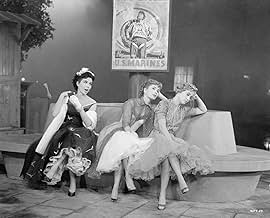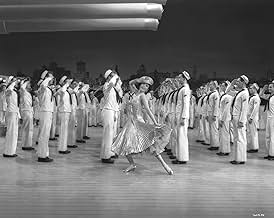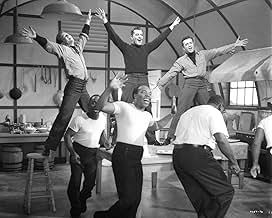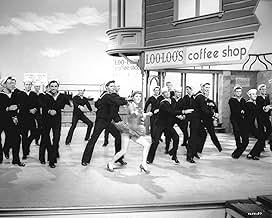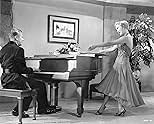IMDb-BEWERTUNG
6,5/10
1047
IHRE BEWERTUNG
Füge eine Handlung in deiner Sprache hinzuThree sailors come ashore in San Francisco and take the city by storm, but can they win the hearts of three women by song?Three sailors come ashore in San Francisco and take the city by storm, but can they win the hearts of three women by song?Three sailors come ashore in San Francisco and take the city by storm, but can they win the hearts of three women by song?
- Auszeichnungen
- 1 wins total
The Jubalaires
- Themselves
- (as Jubalaires)
Jerry Antes
- Dancer
- (Nicht genannt)
Jimmy Brooks
- Dancer
- (Nicht genannt)
Buddy Bryan
- Dancer
- (Nicht genannt)
Empfohlene Bewertungen
Having watched this recently on TCM and not being familiar with the film beforehand, I was drawn in by the quick pace and competent acting, not to mention the pretty leading gals Reynolds and Miller.. quite satisfying eye candy. But then.. came the "fun-house" musical number towards the end and that just blew me away: I mean 'psychedelic' before the word existed, perhaps surreal in contemporaneous nomenclature. That segment stood out as the perhaps the very best part, it was a thrill to watch the choreographed-to-the-second, wild and unpredictable ride of a dance routine! That film was a lot of fun to watch on a lonely night home. So reviewer whoever-you-are that hates every movie unless it has something blowing up every twelve seconds, perhaps stick to writing up Popeye cartoons where the plots and characters aren't too complex for your limited imagination. I recommend movie this as essential viewing for every musical fan.. it won't disappoint.
Some films aren't simply movies-they're time capsules. Hit the Deck (1955), Roy Rowland's lavish adaptation of the 1927 stage musical, shines as a heartfelt homage to the mid-century American musical. It dances through moments of joy, romance, and camaraderie with a sense of purpose: to entertain. While it may lack the narrative finesse of MGM's greatest musicals, its exuberance, star-studded cast, and showstopping numbers make it a delightful-if imperfect-experience.
Hit the Deck carries a legacy that spans decades. Originally a stage musical in 1927 and based on Hubert Osborne's play Shore Leave (1922), it was a roaring success in its day. The story-about love and mischief during sailors' shore leave-captured the carefree spirit of the Roaring Twenties. The stage version's music, penned by Vincent Youmans, became an instant hit, with songs like "Sometimes I'm Happy" and "Hallelujah!" embedding themselves in popular culture.
The transition to screen began with RKO's 1930 adaptation, but MGM's 1955 version added new gloss. By then, the studio was desperate to revive a flagging genre, competing with the rise of television. Roy Rowland's film introduced CinemaScope technology and dazzling Technicolor to reinvigorate the classic material. The film wasn't just a rehash; it aimed to give a modern spin to its predecessors, resulting in a product both nostalgic and forward-looking.
The film's casting is an ode to MGM's star system, featuring legends Jane Powell, Debbie Reynolds, Ann Miller, and Tony Martin. While Powell and Reynolds brought youthful charm and vocal prowess, Miller's fiery energy and tap-dancing skills stole every scene she was in. Russ Tamblyn, despite not being a trained dancer, demonstrated an effortless athleticism that added an endearing spontaneity to his role as the impish Danny.
Behind the camera, choreographer Hermes Pan-Fred Astaire's long-time collaborator-imbued the musical numbers with a sense of joy and improvisation. The battleship finale reprise of "Hallelujah!" is a crowning achievement, blending spectacle with intimacy as sailors and civilians unite in a rousing, free-spirited celebration. The funhouse sequence with Reynolds and Tamblyn is another standout, echoing Fred Astaire's playful "Stiff Upper Lip" number from A Damsel in Distress.
The plot, while serviceable, was less memorable than the musical numbers. It follows three sailors on shore leave, their romantic entanglements, and the inevitable hijinks that ensue. The narrative feels like a patchwork quilt-disjointed but colorful-allowing the cast's charm and musical set pieces to take precedence over storytelling.
At its release, Hit the Deck struggled to recoup its substantial production costs. With box office losses of $454,000, it marked a decline in the MGM musical's golden era. Critics were lukewarm, praising the performances but pointing out the contrived plot and uneven pacing. Audiences, however, found joy in its dazzling musical numbers and the chemistry of its ensemble cast.
Over time, the film has garnered a loyal following among musical enthusiasts. Its inclusion in That's Entertainment! (1974) brought renewed attention, particularly to the finale sequence of "Hallelujah!" This number, celebrated for its improvisational charm, has been hailed as one of MGM's most freewheeling and joyous creations. Russ Tamblyn's athletic performance and Ann Miller's sizzling solo continue to be highlights for fans of classic Hollywood choreography.
The film also represents a bittersweet farewell for many of its stars. Jane Powell, Tony Martin, and J. Carrol Naish made their final MGM appearances here, while Debbie Reynolds and Russ Tamblyn stayed on for a few more years. Their performances encapsulate an era of cinematic magic that, while fading, left a lasting impression.
Hit the Deck may not be MGM's most polished gem, but it shines with the unrestrained joy and heartfelt performances that defined a bygone era. It reminds us of the sheer pleasure of escapist cinema-a kind that only classic Hollywood could deliver. If you're in the mood for vibrant colors, timeless melodies, and a touch of nostalgia, this musical is well worth revisiting.
Hit the Deck carries a legacy that spans decades. Originally a stage musical in 1927 and based on Hubert Osborne's play Shore Leave (1922), it was a roaring success in its day. The story-about love and mischief during sailors' shore leave-captured the carefree spirit of the Roaring Twenties. The stage version's music, penned by Vincent Youmans, became an instant hit, with songs like "Sometimes I'm Happy" and "Hallelujah!" embedding themselves in popular culture.
The transition to screen began with RKO's 1930 adaptation, but MGM's 1955 version added new gloss. By then, the studio was desperate to revive a flagging genre, competing with the rise of television. Roy Rowland's film introduced CinemaScope technology and dazzling Technicolor to reinvigorate the classic material. The film wasn't just a rehash; it aimed to give a modern spin to its predecessors, resulting in a product both nostalgic and forward-looking.
The film's casting is an ode to MGM's star system, featuring legends Jane Powell, Debbie Reynolds, Ann Miller, and Tony Martin. While Powell and Reynolds brought youthful charm and vocal prowess, Miller's fiery energy and tap-dancing skills stole every scene she was in. Russ Tamblyn, despite not being a trained dancer, demonstrated an effortless athleticism that added an endearing spontaneity to his role as the impish Danny.
Behind the camera, choreographer Hermes Pan-Fred Astaire's long-time collaborator-imbued the musical numbers with a sense of joy and improvisation. The battleship finale reprise of "Hallelujah!" is a crowning achievement, blending spectacle with intimacy as sailors and civilians unite in a rousing, free-spirited celebration. The funhouse sequence with Reynolds and Tamblyn is another standout, echoing Fred Astaire's playful "Stiff Upper Lip" number from A Damsel in Distress.
The plot, while serviceable, was less memorable than the musical numbers. It follows three sailors on shore leave, their romantic entanglements, and the inevitable hijinks that ensue. The narrative feels like a patchwork quilt-disjointed but colorful-allowing the cast's charm and musical set pieces to take precedence over storytelling.
At its release, Hit the Deck struggled to recoup its substantial production costs. With box office losses of $454,000, it marked a decline in the MGM musical's golden era. Critics were lukewarm, praising the performances but pointing out the contrived plot and uneven pacing. Audiences, however, found joy in its dazzling musical numbers and the chemistry of its ensemble cast.
Over time, the film has garnered a loyal following among musical enthusiasts. Its inclusion in That's Entertainment! (1974) brought renewed attention, particularly to the finale sequence of "Hallelujah!" This number, celebrated for its improvisational charm, has been hailed as one of MGM's most freewheeling and joyous creations. Russ Tamblyn's athletic performance and Ann Miller's sizzling solo continue to be highlights for fans of classic Hollywood choreography.
The film also represents a bittersweet farewell for many of its stars. Jane Powell, Tony Martin, and J. Carrol Naish made their final MGM appearances here, while Debbie Reynolds and Russ Tamblyn stayed on for a few more years. Their performances encapsulate an era of cinematic magic that, while fading, left a lasting impression.
Hit the Deck may not be MGM's most polished gem, but it shines with the unrestrained joy and heartfelt performances that defined a bygone era. It reminds us of the sheer pleasure of escapist cinema-a kind that only classic Hollywood could deliver. If you're in the mood for vibrant colors, timeless melodies, and a touch of nostalgia, this musical is well worth revisiting.
HIT THE DECK is a 1955 cinema scope mop up of MGM stars and talent whose contracts would have been soon to expire. A bit like a aircraft carrier version of DEEP IN MY HEART it hangs together a roster of singing and dancing talent but this time with ultimately fairly just-OK songs and energetic dance numbers. Still, even at its most bland it is still unable to be made in Hollywood today. The women are the most interesting talent on offer and whoever said Tony Martin had an audience apart from Mummas in delicatessens was truly misled. He is the most annoying part of this B grade musical with A grade MGM production values. Like he did with the Marx Bros films in the 30s. Kelly was making ITS ALWAYS FAIR WEATHER another 'sailors on leave' 1955 cinema scope MGM musical at the same time and that film with its Comden Green script and songs is light years ahead in sophistication and quality. Still HIT THE DECK has a two of very entertaining 'big' dance numbers, in particular the "finale" and the "Bayou" sizzler with its very erotic and blatant imagery and choreography. It is so out of place in this 'suburban' film as it is sooo good. The color is also very good for Eastman since MGM saw the error of their ways and stopped using horrible Ansco color which visually marred several big films in 53 and 54. This must have been as safe a bet in which MGM could expect to play out as many stars as possible in yet one more sailor musical. Russ Tamblyn and Debbie Reynolds are always cute in this era though.
Another of MGM's sailors-on-leave musicals, a small-time 'On the Town' designed to utilize their formidable roster of singing and dancing talent. Tony Martin, Vic Damone and Russ Tamblyn are the sailors on leave in San Francisco. The girls they meet are Jane Powell, Ann Miller and Debbie Reynolds. With the Shore Patrol headed by comic Alan King, you can be sure everything's played for laughs before matters get straightened out.
The grand finale aboard ship is a show-stopping number and for this the letterbox format is used to take full advantage of the choreography and music staged by Hermes Pan. In the tradition of 'On the Town' and 'Anchors Aweigh' (but with much more modest results), this is a happy go lucky musical that aims to please but falls just a bit short of its mark. No fault of the performers--they're all fine. It's the weak script based on a 1927 Broadway smash, updated for so-so results.
Jane Powell and Vic Damone are in fine voice, and Russ Tamblyn and Ann Miller provide plenty of top-notch dancing. If you're in the mood for the shore leave kind of musical, this will do nicely.
The grand finale aboard ship is a show-stopping number and for this the letterbox format is used to take full advantage of the choreography and music staged by Hermes Pan. In the tradition of 'On the Town' and 'Anchors Aweigh' (but with much more modest results), this is a happy go lucky musical that aims to please but falls just a bit short of its mark. No fault of the performers--they're all fine. It's the weak script based on a 1927 Broadway smash, updated for so-so results.
Jane Powell and Vic Damone are in fine voice, and Russ Tamblyn and Ann Miller provide plenty of top-notch dancing. If you're in the mood for the shore leave kind of musical, this will do nicely.
The play Shore Leave was given another and final musical adaption in 1955 serving as a great showcase for some mighty talented stars at MGM. Vincent Youmans and Irving Caesar wrote the original musical Hit the Deck for Broadway in the twenties and an film adaption was done in 1930 starring Jack Oakie. Then Irving Berlin did his own version for the screen in Follow the Fleet for Fred and Ginger.
Come 1955 and we have still another script retaining some of the Youmans-Caesar songs and adding several Youmans numbers from other shows. The songs are well integrated into the story since it involves some sailors on shore leave in San Francisco involved with some musical performers.
The sailors are Tony Martin, Vic Damone, and Russ Tamblyn. Martin and Damone are two of the best voices around and Tamblyn is a good dancer. They pair off with Ann Miller, Jane Powell, and Debbie Reynolds.
Martin is having trouble with Miller, they have a Nathan Detroit/Adelaide relationship long distance and she's tired of it. In the mean time Powell who is Tamblyn's sister is involved with a Broadway wolf played with relish by Gene Raymond. Both are the offspring of Admiral Walter Pidgeon.
Anyway our sailors rescue damsel in distress Powell and spend most of the film hiding from the Shore Patrol. One of the two Shore Patrolmen is played by Alan King who was appearing with Martin in his nightclub act and Martin got the part for him in Hit the Deck.
Powell and Damone had already been a screen team in Rich, Young and Pretty and also had appeared in Deep in My Heart together in a musical number. They do a two nice duets with a couple of noted Youmans songs I Know that You Know and Sometimes I'm Happy. Martin's big solo number is the famous More Than You Know trying to win Miller back. And our Ann dances to Keeping Myself for You, Bayou, and the Hallelujah finale number.
Up till Showboat, musicals in fact had thin plots for stories and were just an excuse for singing and dancing. Hit the Deck is a throwback to those days. But a nicely done throwback.
Of course Ann Miller is just fine, but why oh why didn't MGM cast Cyd Charisse opposite her husband? Missed another opportunity.
Look for Richard Anderson who has a small role as the aide to Walter Pidgeon. In a very understated way he's the one who brings about a satisfactory conclusion to one and all.
Come 1955 and we have still another script retaining some of the Youmans-Caesar songs and adding several Youmans numbers from other shows. The songs are well integrated into the story since it involves some sailors on shore leave in San Francisco involved with some musical performers.
The sailors are Tony Martin, Vic Damone, and Russ Tamblyn. Martin and Damone are two of the best voices around and Tamblyn is a good dancer. They pair off with Ann Miller, Jane Powell, and Debbie Reynolds.
Martin is having trouble with Miller, they have a Nathan Detroit/Adelaide relationship long distance and she's tired of it. In the mean time Powell who is Tamblyn's sister is involved with a Broadway wolf played with relish by Gene Raymond. Both are the offspring of Admiral Walter Pidgeon.
Anyway our sailors rescue damsel in distress Powell and spend most of the film hiding from the Shore Patrol. One of the two Shore Patrolmen is played by Alan King who was appearing with Martin in his nightclub act and Martin got the part for him in Hit the Deck.
Powell and Damone had already been a screen team in Rich, Young and Pretty and also had appeared in Deep in My Heart together in a musical number. They do a two nice duets with a couple of noted Youmans songs I Know that You Know and Sometimes I'm Happy. Martin's big solo number is the famous More Than You Know trying to win Miller back. And our Ann dances to Keeping Myself for You, Bayou, and the Hallelujah finale number.
Up till Showboat, musicals in fact had thin plots for stories and were just an excuse for singing and dancing. Hit the Deck is a throwback to those days. But a nicely done throwback.
Of course Ann Miller is just fine, but why oh why didn't MGM cast Cyd Charisse opposite her husband? Missed another opportunity.
Look for Richard Anderson who has a small role as the aide to Walter Pidgeon. In a very understated way he's the one who brings about a satisfactory conclusion to one and all.
Wusstest du schon
- WissenswertesBased on his athletic dancing in films such as this one and Der kleine Däumling (1958), most audiences assume that Russ Tamblyn was a trained dancer. In fact, the actor had no history of dance training. He was a skilled tumbler, and that was originally slated to be his singular contribution to Eine Braut für sieben Brüder (1954), but his natural movement ability was so accomplished that he was incorporated more and more into the dance sequences. This would ultimately culminate in his being cast as Riff in West Side Story (1961), one of the most dance-heavy musicals in Broadway history.
- Zitate
Chief Boatswain's Mate William F. Clark: Ginger, baby, I worship the ground you walk on!
Ginger: Now he's talking real estate!
- Crazy CreditsAnd Introducing Kay Armen
- VerbindungenFeatured in 1955 Motion Picture Theatre Celebration (1955)
- SoundtracksOverture (Join the Navy)
(1927) (uncredited)
Music by Vincent Youmans
Lyrics by Leo Robin and Clifford Grey
Performed by the MGM Studio Orchestra and Chorus Conducted by George Stoll
Top-Auswahl
Melde dich zum Bewerten an und greife auf die Watchlist für personalisierte Empfehlungen zu.
- How long is Hit the Deck?Powered by Alexa
Details
- Erscheinungsdatum
- Herkunftsland
- Sprache
- Auch bekannt als
- ¡Qué pícaras mujeres!
- Drehorte
- San Francisco, Kalifornien, USA(backgrounds)
- Produktionsfirma
- Weitere beteiligte Unternehmen bei IMDbPro anzeigen
Box Office
- Budget
- 2.300.000 $ (geschätzt)
- Laufzeit1 Stunde 52 Minuten
- Sound-Mix
- 4-Track Stereo(original master sound track)
- Seitenverhältnis
- 2.55 : 1
Zu dieser Seite beitragen
Bearbeitung vorschlagen oder fehlenden Inhalt hinzufügen

Oberste Lücke
By what name was In Frisco vor Anker (1955) officially released in India in English?
Antwort



